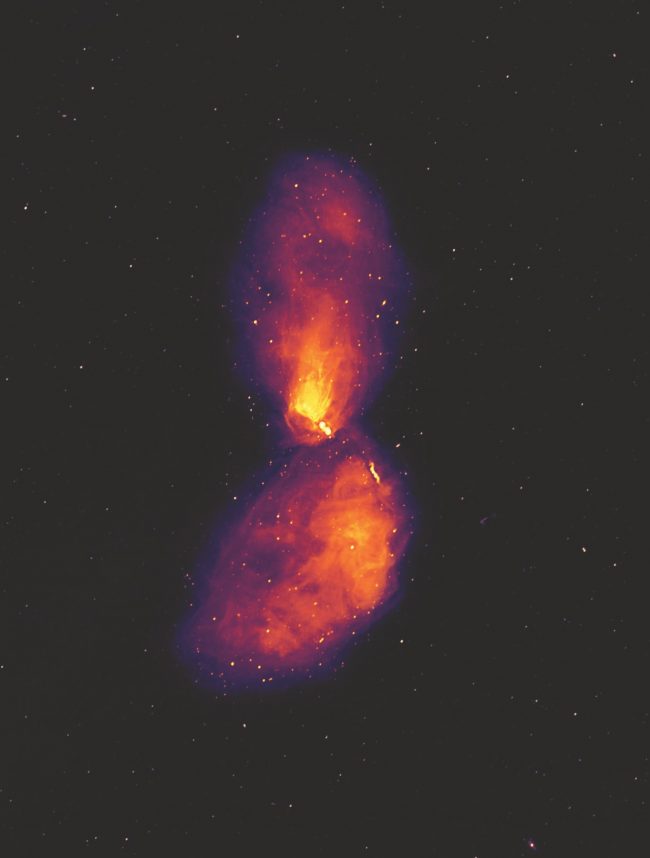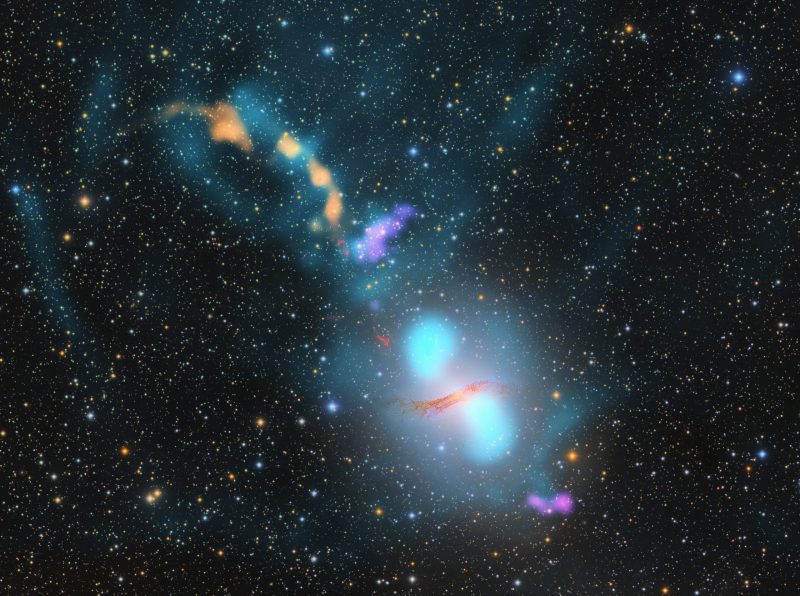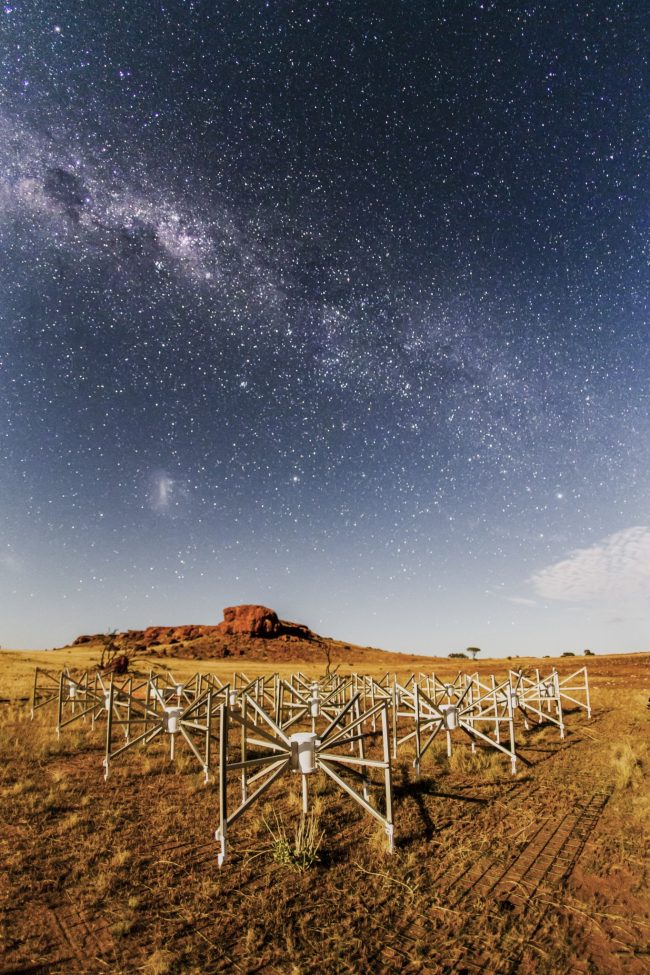Scientists announced December 23, 2021, that they used the Murchison Widefield Array (MWA) telescope in the outback of Western Australia to produce the most comprehensive image yet of the black hole eruption in the galaxy Centaurus A. This galaxy contains the nearest actively feeding supermassive black hole to Earth. The eruptive radio bubble from the black hole spans the length of 16 full moons in our sky, despite the fact that it’s 12 million light-years away.
As the black hole consumes stars and dust in this faraway galaxy, it produces jets that shoot material out at near light-speed, creating the giant radio bubbles. The radio bubbles are 8 degrees in length (a full moon spans half a degree) and hundreds of millions of years old.
The peer-reviewed journal Nature Astronomy published the study with the radio map of Centaurus A on December 22, 2021.
The 2022 lunar calendars are here. Onely a few left. Order yours before they’re gone!
New map shows black hole eruption
Curtin Observatory in Australia operates the radio telescopes of the Murchison Widefield Array. Benjamin McKinley of Curtin University was the lead author of the new study that produced the black hole map. McKinley described the map:
These radio waves come from material being sucked into the supermassive black hole in the middle of the galaxy. It forms a disk around the black hole, and as the matter gets ripped apart going close to the black hole, powerful jets form on either side of the disk, ejecting most of the material back out into space, to distances of probably more than a million light-years. Previous radio observations could not handle the extreme brightness of the jets and details of the larger area surrounding the galaxy were distorted, but our new image overcomes these limitations.

Centaurus A, closest radio galaxy to us
Centaurus A, or NGC 5128, is an elliptical galaxy that’s the closest radio galaxy to our own Milky Way. Because it’s relatively close to Earth, it’s a good target for astronomers to study the active supermassive black hole at its core. This black hole contains the mass of about 55 million suns and has incredible jets shooting out to 1.8 million light-years in extent.
McKinley said:
We can learn a lot from Centaurus A in particular, just because it is so close and we can see it in such detail. Not just at radio wavelengths, but at all other wavelengths of light as well. In this research we’ve been able to combine the radio observations with optical and x-ray data to help us better understand the physics of these supermassive black holes.

Formation of the radio jets
What’s going on in this galaxy to create the immense jets? Massimo Gaspari of Italy’s National Institute for Astrophysics said that their study corroborated a theory called “Chaotic Cold Accretion.” Gaspari explained:
In this model, clouds of cold gas condense in the galactic halo and rain down onto the central regions, feeding the supermassive black hole. Triggered by this rain, the black hole vigorously reacts by launching energy back via radio jets that inflate the spectacular lobes we see in the MWA image. This study is one of the first to probe in such detail the multiphase CCA [Chaotic Cold Accretion] ‘weather’ over the full range of scales.
McKinley described how the center of the galaxy is bright where most of the activity and energy is, and:
… then it’s fainter as you go out because the energy’s been lost and things have settled down. But there are interesting features where charged particles have re-accelerated and are interacting with strong magnetic fields.

The scientists look forward to learning more about Centaurus A when the world’s largest radio telescope, the Square Kilometer Array, goes online.
Bottom line: Scientists used the Murchison Widefield Array radio telescope to take the most detailed image yet of the enormous nebulae surrounding the supermassive black hole at the center of galaxy Centaurus A.
Source: Multi-scale feedback and feeding in the closest radio galaxy Centaurus A
The post Black hole eruption the size of 16 full moons first appeared on EarthSky.
from EarthSky https://ift.tt/3G9w9hx
Scientists announced December 23, 2021, that they used the Murchison Widefield Array (MWA) telescope in the outback of Western Australia to produce the most comprehensive image yet of the black hole eruption in the galaxy Centaurus A. This galaxy contains the nearest actively feeding supermassive black hole to Earth. The eruptive radio bubble from the black hole spans the length of 16 full moons in our sky, despite the fact that it’s 12 million light-years away.
As the black hole consumes stars and dust in this faraway galaxy, it produces jets that shoot material out at near light-speed, creating the giant radio bubbles. The radio bubbles are 8 degrees in length (a full moon spans half a degree) and hundreds of millions of years old.
The peer-reviewed journal Nature Astronomy published the study with the radio map of Centaurus A on December 22, 2021.
The 2022 lunar calendars are here. Onely a few left. Order yours before they’re gone!
New map shows black hole eruption
Curtin Observatory in Australia operates the radio telescopes of the Murchison Widefield Array. Benjamin McKinley of Curtin University was the lead author of the new study that produced the black hole map. McKinley described the map:
These radio waves come from material being sucked into the supermassive black hole in the middle of the galaxy. It forms a disk around the black hole, and as the matter gets ripped apart going close to the black hole, powerful jets form on either side of the disk, ejecting most of the material back out into space, to distances of probably more than a million light-years. Previous radio observations could not handle the extreme brightness of the jets and details of the larger area surrounding the galaxy were distorted, but our new image overcomes these limitations.

Centaurus A, closest radio galaxy to us
Centaurus A, or NGC 5128, is an elliptical galaxy that’s the closest radio galaxy to our own Milky Way. Because it’s relatively close to Earth, it’s a good target for astronomers to study the active supermassive black hole at its core. This black hole contains the mass of about 55 million suns and has incredible jets shooting out to 1.8 million light-years in extent.
McKinley said:
We can learn a lot from Centaurus A in particular, just because it is so close and we can see it in such detail. Not just at radio wavelengths, but at all other wavelengths of light as well. In this research we’ve been able to combine the radio observations with optical and x-ray data to help us better understand the physics of these supermassive black holes.

Formation of the radio jets
What’s going on in this galaxy to create the immense jets? Massimo Gaspari of Italy’s National Institute for Astrophysics said that their study corroborated a theory called “Chaotic Cold Accretion.” Gaspari explained:
In this model, clouds of cold gas condense in the galactic halo and rain down onto the central regions, feeding the supermassive black hole. Triggered by this rain, the black hole vigorously reacts by launching energy back via radio jets that inflate the spectacular lobes we see in the MWA image. This study is one of the first to probe in such detail the multiphase CCA [Chaotic Cold Accretion] ‘weather’ over the full range of scales.
McKinley described how the center of the galaxy is bright where most of the activity and energy is, and:
… then it’s fainter as you go out because the energy’s been lost and things have settled down. But there are interesting features where charged particles have re-accelerated and are interacting with strong magnetic fields.

The scientists look forward to learning more about Centaurus A when the world’s largest radio telescope, the Square Kilometer Array, goes online.
Bottom line: Scientists used the Murchison Widefield Array radio telescope to take the most detailed image yet of the enormous nebulae surrounding the supermassive black hole at the center of galaxy Centaurus A.
Source: Multi-scale feedback and feeding in the closest radio galaxy Centaurus A
The post Black hole eruption the size of 16 full moons first appeared on EarthSky.
from EarthSky https://ift.tt/3G9w9hx

Aucun commentaire:
Enregistrer un commentaire